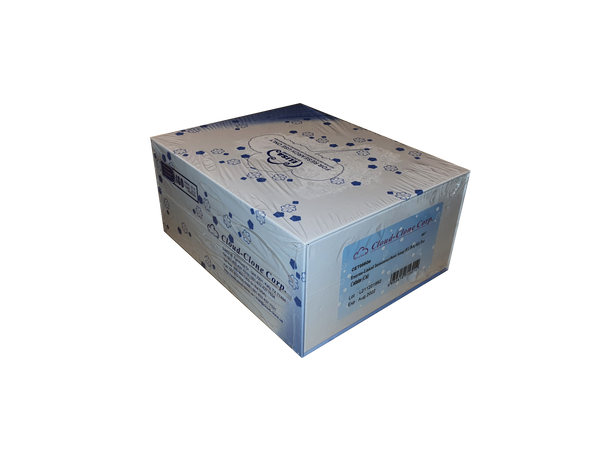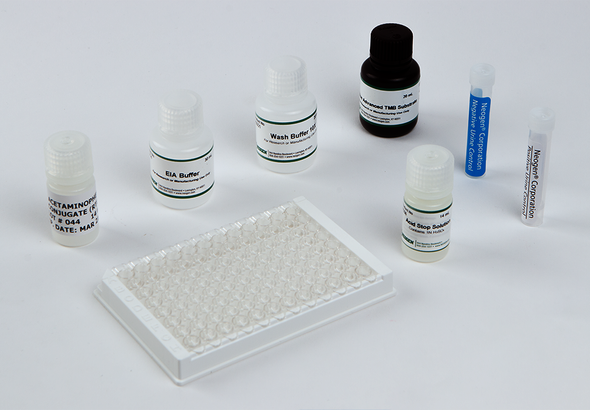ELISA Kit for Cotinine (Cot) | CET058Ge
- SKU:
- CET058Ge
- Availability:
- 5 Working Days
- Method:
- Competitive Inhibition
- Sample Type:
- Serum, plasma, tissue homogenates, cell lysates, cell culture supernates & other biological fluids
- Detection range:
- 617.3-50,000pg/mL
Description
Download Product Documentation
INTENDED USE
The kit is a competitive inhibition enzyme immunoassay technique for the in vitro quantitative measurement of cotinine in serum, plasma, tissue homogenates, cell lysates, cell culture supernates and other biological fluids.
REAGENTS AND MATERIALS PROVIDED

MATERIALS REQUIRED BUT NOT SUPPLIED
1. Microplate reader with 450 ± 10nm filter.
2. Single or multi-channel pipettes with high precision and disposable tips.
3. Microcentrifuge Tubes.
4. Deionized or distilled water.
5. Absorbent paper for blotting the microplate.
6. Container for Wash Solution.
7. 0.01mol/L (or 1×) Phosphate Buffered Saline(PBS), pH7.0-7.2.
STORAGE OF THE KITS
1. For unopened kit: All the reagents should be kept according to the labels on vials. The Standard, Detection Reagent A, Detection Reagent B and the 96-well strip plate should be stored at -20oC upon receipt while the others should be at 4oC.
2. For used kit: When the kit is used, the remaining reagents need to be stored according to the above storage condition. Besides, please return the unused wells to the foil pouch containing the desiccant pack, and zip-seal the foil pouch.
Note:
It is highly recommended to use the remaining reagents within 1 month provided this is prior to the expiration date of the kit. For the expiration date of the kit, please refer to the label on the kit box. All components are stable up to the expiration date.
SAMPLE COLLECTION AND STORAGE
Serum - Use a serum separator tube and allow samples to clot for two hours at room temperature or overnight at
4oC before centrifugation for 20 minutes at approximately 1,000×g. Assay freshly prepared serum immediately or store samples in aliquot at -20oC or -80oC for later use. Avoid repeated freeze/thaw cycles. Plasma - Collect plasma using EDTA or heparin as an anticoagulant. Centrifuge samples for 15 minutes at 1,000×g at 2-8oC within 30 minutes of collection. Remove plasma and assay immediately or store samples in aliquot at -20oC or -80oC for later use. Avoid repeated freeze/thaw cycles.
Tissue homogenates - The preparation of tissue homogenates will vary depending upon tissue type.
1. Tissues were rinsed in ice-cold PBS to remove excess blood thoroughly and weighed before homogenization.
2. Minced the tissues to small pieces and homogenized them in fresh lysis buffer (catalog: IS007, different lysis buffer needs to be chosen based on subcellular location of the target protein) (w:v = 1:20-1:50, e.g. 1mL lysis buffer is added in 20-50mg tissue sample) with a glass homogenizer on ice (Micro Tissue Grinders woks, too).
3. The resulting suspension was sonicated with an ultrasonic cell disrupter till the solution is clarified.
4. Then, the homogenates were centrifuged for 5 minutes at 10,000×g. Collect the supernates and assay immediately or aliquot and store at ≤-20oC.
Cell Lysates - Cells need to be lysed before assaying according to the following directions.
1. Adherent cells should be washed by cold PBS gently, and then detached with trypsin, and collected by centrifugation at 1,000×g for 5 minutes (suspension cells can be collected by centrifugation directly).
2. Wash cells three times in cold PBS.
3. Resuspend cells in fresh lysis buffer with concentration of 107 cells/mL. If it is necessary, the cells could be subjected to ultrasonication till the solution is clarified.
4. Centrifuge at 1,500×g for 10 minutes at 2-8oC to remove cellular debris. Assay immediately or aliquot and store at ≤-20oC.
Cell culture supernates and other biological fluids - Centrifuge samples for 20 minutes at 1,000×g. Collect the
supernates and assay immediately or store samples in aliquot at -20oC or -80oC for later use. Avoid repeated freeze/thaw cycles.
Note:
1. Samples to be used within 5 days may be stored at 4oC, otherwise samples must be stored at -20oC (≤1 month) or -80oC (≤2 months) to avoid loss of bioactivity and contamination.
2. Sample hemolysis will influence the result, so hemolytic specimen should not be used.
3. When performing the assay, bring samples to room temperature.
4. It is highly recommended to use serum instead of plasma for the detection based on quantity of our in-house data.






